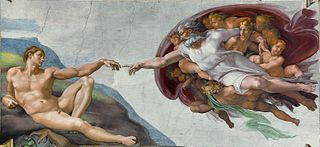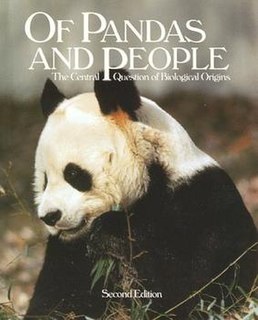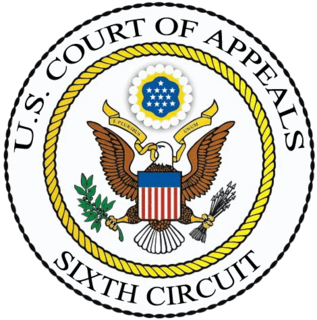Related Research Articles

Creation science or scientific creationism is a pseudoscientific form of Young Earth creationism which claims to offer scientific arguments for certain literalist and inerrantist interpretations of the Bible. It is often presented without overt faith-based language, but instead relies on reinterpreting scientific results to argue that various myths in the Book of Genesis and other select biblical passages are scientifically valid. The most commonly advanced ideas of creation science include special creation based on the Genesis creation narrative and flood geology based on the Genesis flood narrative. Creationists also claim they can disprove or reexplain a variety of scientific facts, theories and paradigms of geology, cosmology, biological evolution, archaeology, history, and linguistics using creation science. Creation science was foundational to intelligent design.

Intelligent design (ID) is a pseudoscientific argument for the existence of God, presented by its proponents as "an evidence-based scientific theory about life's origins". Proponents claim that "certain features of the universe and of living things are best explained by an intelligent cause, not an undirected process such as natural selection." ID is a form of creationism that lacks empirical support and offers no testable or tenable hypotheses, and is therefore not science. The leading proponents of ID are associated with the Discovery Institute, a Christian, politically conservative think tank based in the United States.
Edwards v. Aguillard, 482 U.S. 578 (1987), was a United States Supreme Court case concerning the constitutionality of teaching creationism. The Court considered a Louisiana law requiring that where evolutionary science was taught in public schools, creation science must also be taught. The constitutionality of the law was successfully challenged in District Court, Aguillard v. Treen, 634 F. Supp. 426, and the United States Court of Appeals for the Fifth Circuit affirmed, Aguillard v. Edwards, 765 F.2d 1251. The United States Supreme Court ruled that this law violated the Establishment Clause of the First Amendment because the law was specifically intended to advance a particular religion. In its decision, the court opined that "teaching a variety of scientific theories about the origins of humankind to school children might be validly done with the clear secular intent of enhancing the effectiveness of science instruction."
Icons of Evolution is a book by Jonathan Wells, an advocate of the pseudoscientific intelligent design argument for the existence of God and fellow of the Discovery Institute, in which Wells criticizes the paradigm of evolution by attacking how it is taught. The book includes a 2002 video companion. In 2000, Wells summarized the book's contents in an article in the American Spectator. Several of the scientists whose work is sourced in the book have written rebuttals to Wells, stating that they were quoted out of context, that their work has been misrepresented, or that it does not imply Wells's conclusions.

Recurring cultural, political, and theological rejection of evolution by religious groups exists regarding the origins of the Earth, of humanity, and of other life. In accordance with creationism, species were once widely believed to be fixed products of divine creation, but since the mid-19th century, evolution by natural selection has been established by the scientific community as an empirical scientific fact.

The history of creationism relates to the history of thought based on the premise that the natural universe had a beginning, and came into being supernaturally. The term creationism in its broad sense covers a wide range of views and interpretations, and was not in common use before the late 19th century. Throughout recorded history, many people have viewed the universe as a created entity. Many ancient historical accounts from around the world refer to or imply a creation of the earth and universe. Although specific historical understandings of creationism have used varying degrees of empirical, spiritual and/or philosophical investigations, they are all based on the view that the universe was created. The Genesis creation narrative has provided a basic framework for Jewish and Christian epistemological understandings of how the universe came into being – through the divine intervention of the god, Yahweh. Historically, literal interpretations of this narrative were more dominant than allegorical ones.

The status of creation and evolution in public education has been the subject of substantial debate and conflict in legal, political, and religious circles. Globally, there is a wide variety of views on the topic. Most western countries have legislation that mandates only evolutionary biology is to be taught in the appropriate scientific syllabuses.

The Creation Research Society (CRS) is a Christian fundamentalist group that requires of its members belief that the Bible is historically and scientifically true in the original autographs, belief that "original created kinds" of all living things were created during the Creation week described in Genesis, and belief in flood geology.

Of Pandas and People: The Central Question of Biological Origins is a controversial 1989 school-level supplementary textbook written by Percival Davis and Dean H. Kenyon, edited by Charles Thaxton and published by the Texas-based Foundation for Thought and Ethics (FTE). The textbook endorses the pseudoscientific concept of intelligent design – the argument that life shows evidence of being designed by an intelligent agent which is not named specifically in the book, although proponents understand that it refers to the Christian God. The overview chapter was written by young Earth creationist Nancy Pearcey. They present various polemical arguments against the scientific theory of evolution. Before publication, early drafts used cognates of "creationist". After the Edwards v. Aguillard Supreme Court ruling that creationism is religion and not science, these were changed to refer to "intelligent design". The second edition published in 1993 included a contribution written by Michael Behe.

McLean v. Arkansas Board of Education, 529 F. Supp. 1255, was a 1981 legal case in the US state of Arkansas.
Devolution, de-evolution, or backward evolution is the notion that species can revert to supposedly more primitive forms over time. The concept relates to the idea that evolution has a purpose (teleology) and is progressive (orthogenesis), for example that feet might be better than hooves or lungs than gills. However, evolutionary biology makes no such assumptions, and natural selection shapes adaptations with no foreknowledge of any kind. It is possible for small changes to be reversed by chance or selection, but this is no different from the normal course of evolution and as such de-evolution is not compatible with a proper understanding of evolution due to natural selection.
Thomas G. Barnes was an American creationist, who argued in support of his religious belief in a young earth by making the faulty scientific claims that the Earth's magnetic field was consistently decaying.

Daniel v. Waters, 515 F.2d 485 was a 1975 legal case in which the United States Court of Appeals for the Sixth Circuit struck down Tennessee's law regarding the teaching of "equal time" of evolution and creationism in public school science classes because it violated the Establishment clause of the US Constitution.
Hendren et al. v. Campbell et al. was a 1977 ruling by an Indiana state superior court that the young-earth creationist textbook could not be used in Indiana public schools. Jon Hendren, a ninth-grade student in the West Clark Community Schools, sued when the district picked Biology: A Search For Order In Complexity, published by the Creation Research Society and promoted through the Institute for Creation Research, as the sole biology textbook. The textbook was edited by creationists John N. Moore and Harold Schultz Slusher.

Rejection of evolution by religious groups, sometimes called creation–evolution controversy, has a long history. In response to theories developed by scientists, some religious individuals and organizations questioned the legitimacy of scientific ideas that contradicted the literal interpretation of the creation account in Genesis. Interpretation of the Judeo-Christian Bible had long been the prerogative of an orthodox priesthood able to understand Latin who traditionally held that Genesis was not meant to be read literally and taught it as an allegory. With the advent of the printing press, the translation of the Bible into other languages, and wider literacy, sundry and more literal understandings of scripture flourished. This allowed some religious persons and groups to challenge scientists who supported evolution, such as biologists Thomas Henry Huxley and Ernst Haeckel.

Objections to evolution have been raised since evolutionary ideas came to prominence in the 19th century. When Charles Darwin published his 1859 book On the Origin of Species, his theory of evolution initially met opposition from scientists with different theories, but eventually came to receive overwhelming acceptance in the scientific community. The observation of evolutionary processes occurring has been uncontroversial among mainstream biologists since the 1940s.

This timeline of intelligent design outlines the major events in the development of intelligent design as presented and promoted by the intelligent design movement.

Explore Evolution: The Arguments For and Against Neo-Darwinism is a controversial biology textbook written by a group of intelligent design supporters and published in 2007. Its promoters describe it as aimed at helping educators and students to discuss "the controversial aspects of evolutionary theory that are discussed openly in scientific books and journals but which are not widely reported in textbooks." As one of the Discovery Institute intelligent design campaigns to "teach the controversy" its evident purpose is to provide a "lawsuit-proof" way of attacking evolution and promoting pseudoscientific creationism without being explicit.

The discovery of nylon-eating bacteria has been used to educate and challenge creationist arguments against evolution and natural selection. These bacteria can produce novel enzymes that allow them to feed on by-products of nylon manufacture which did not exist prior to the invention of nylon in the 1930s. Observation of these adaptations refute religious and pseudoscientific claims that no new information can be added to a genome and that proteins are too complex to evolve through a process of mutation and natural selection. Apologists have produced reactionary literature attempting to deny that evolution occurs, in turn generating input from the scientific community.
Frank Boyer Salisbury was an American plant physiologist who served for a time as head of the Utah State University (USU) department of plant science.
References
- ↑ Numbers, Ronald L. (1993). The Creationists . University of California Press. pp. 199.
- ↑ Vickers, Brett (31 May 2002). "Some Questionable Creationist Credentials". TalkOrigins. Retrieved 29 August 2016.
- ↑ "Harold Slusher". University of Texas at El Paso. Retrieved 29 August 2016.
- ↑ Klotz, Irving (2013). Diamond Dealers and Feather Merchants: Tales from the Sciences. Springer Science & Business Media. p. 111.
- ↑ Frazier, Kendrick (1986). Science Confronts the Paranormal. Prometheus Books. p. 314.
- ↑ Klotz, Irving M (1982). "Commentary: Why Not Teach Creationism in the Schools?". BioScience . 32 (5): 334–335.
- ↑ "Creationism: Intellectual Origins, Cultural Context, and Theoretical Diversity". Thomas Allen McIver, 1989.
- 1 2 3 4 5 Simpson, Ronald D; Anderson, Wyatt W. (1975). "Reviewed Work: SAME SONG, SECOND VERSE—A Review of Biology: A Search for Order in Complexity, Revised Edition by John N. Moore, Harold Schultz Slusher". The Science Teacher . 42 (5): 40–42.
{{cite journal}}: CS1 maint: multiple names: authors list (link) - ↑ Mariner, James L; McBurney, Wendell F. (1971). "Reviewed Work: Biology: A Search for Order in Complexity by John N. Moore, Harold Schultz Slusher". The American Biology Teacher . 33 (7): 438–442.
{{cite journal}}: CS1 maint: multiple names: authors list (link) - ↑ "Review: Biology: A Search for Order in Complexity". National Center for Science Education. Retrieved 30 January 2021.
- ↑ Hendren v. Campbell. 1977. Marion County Superior Court. No. 5, Indiana. Case No. S577-0139.
- ↑ Fowler, Dean R. (1982). "The Creationist Movement". The American Biology Teacher . 44 (9): 528–542.